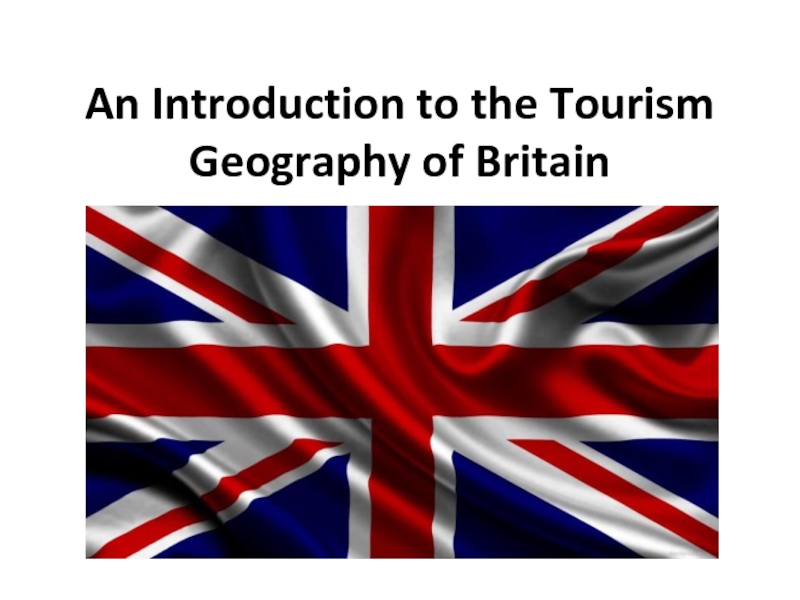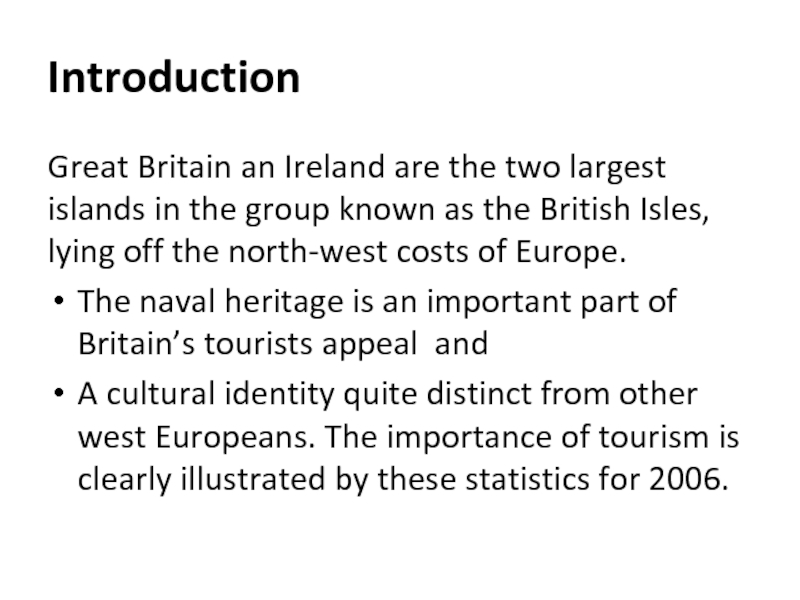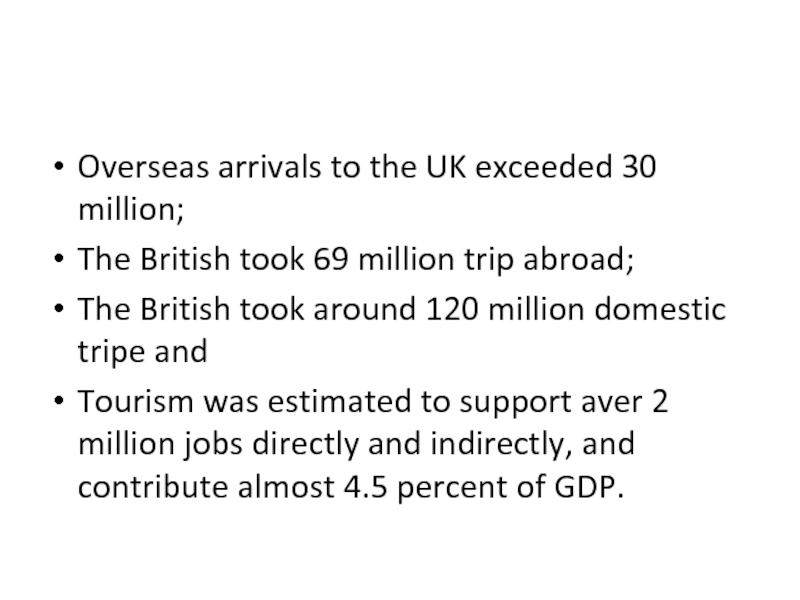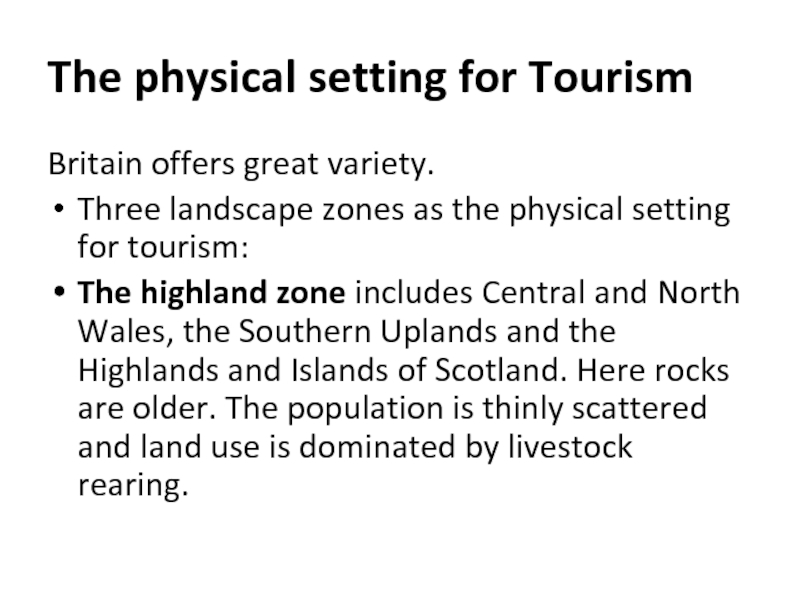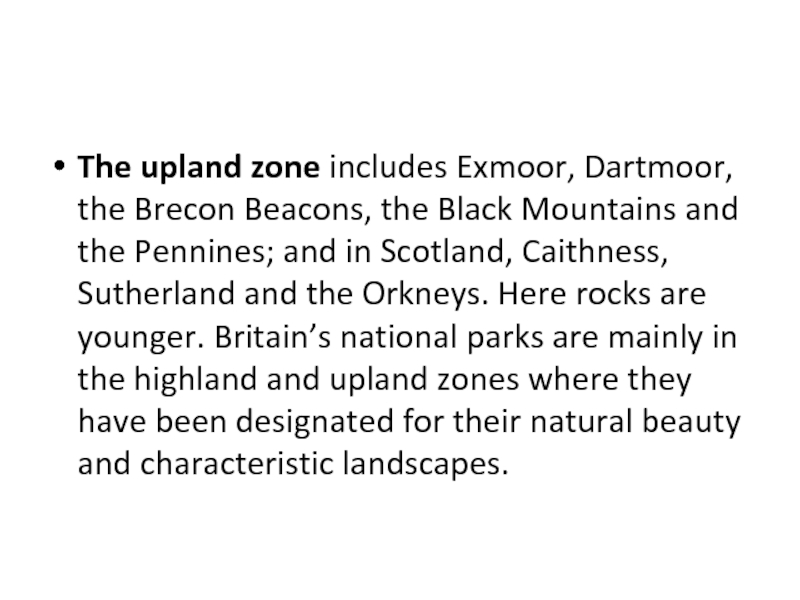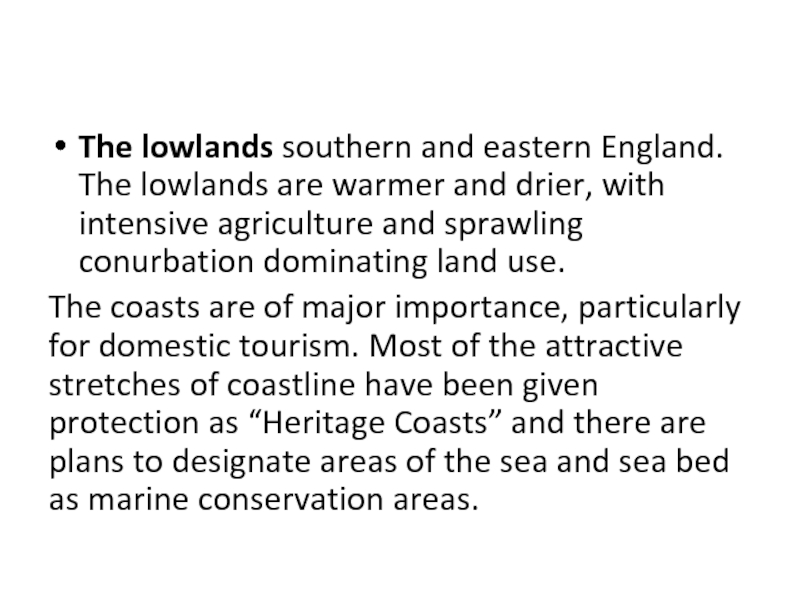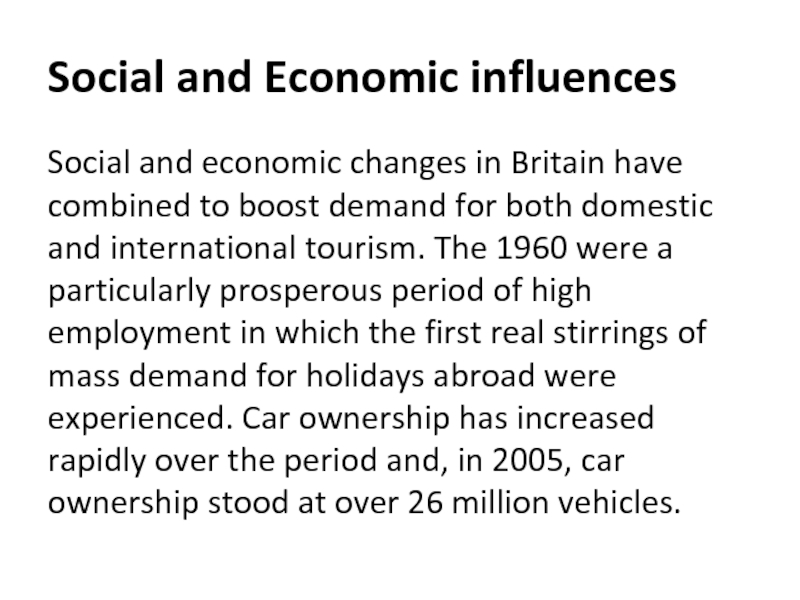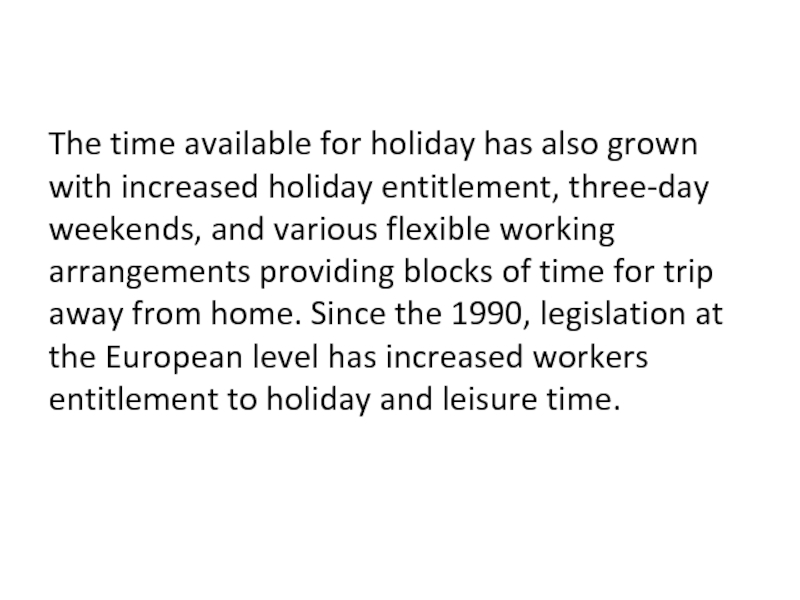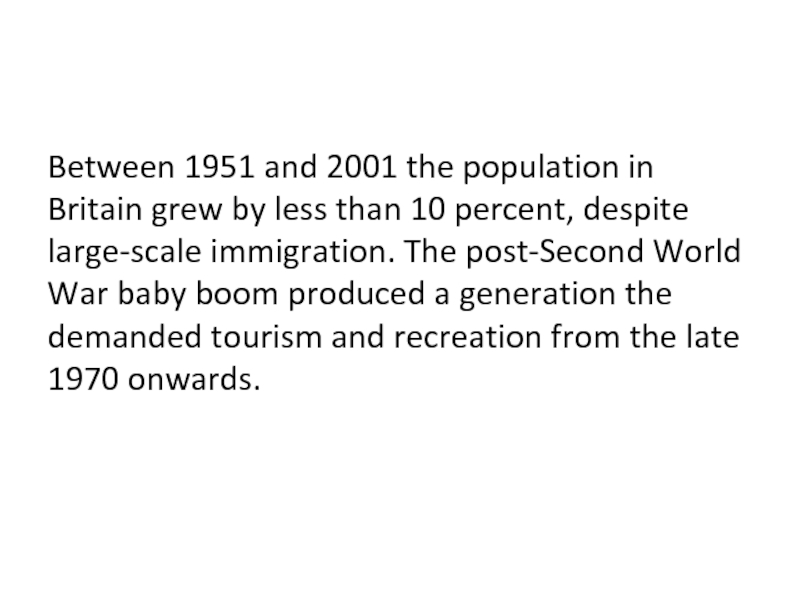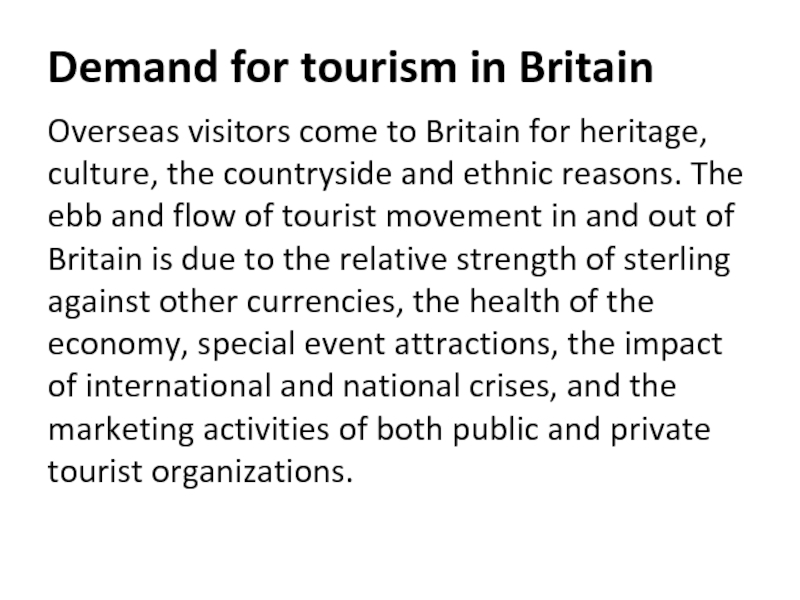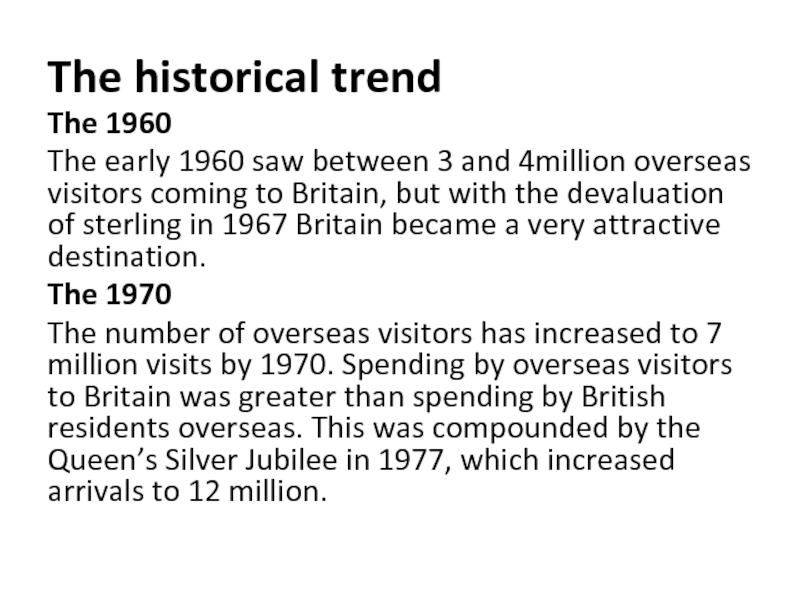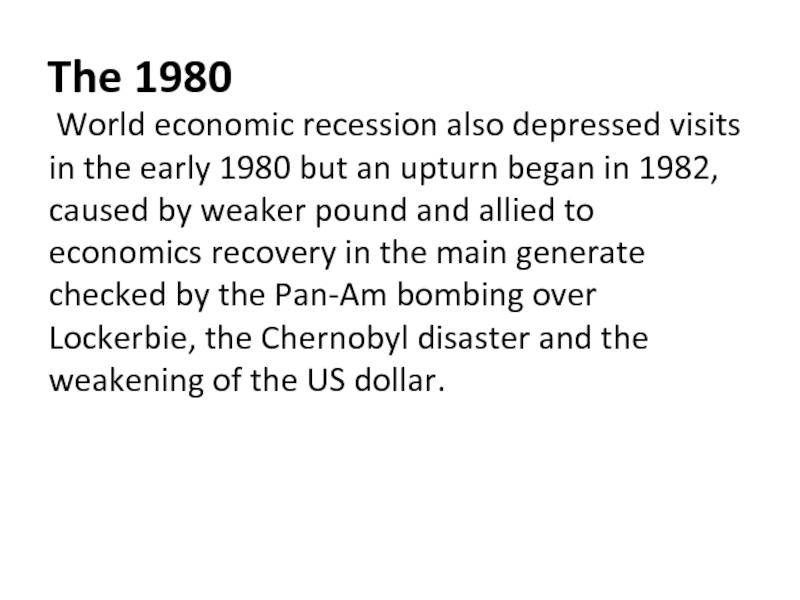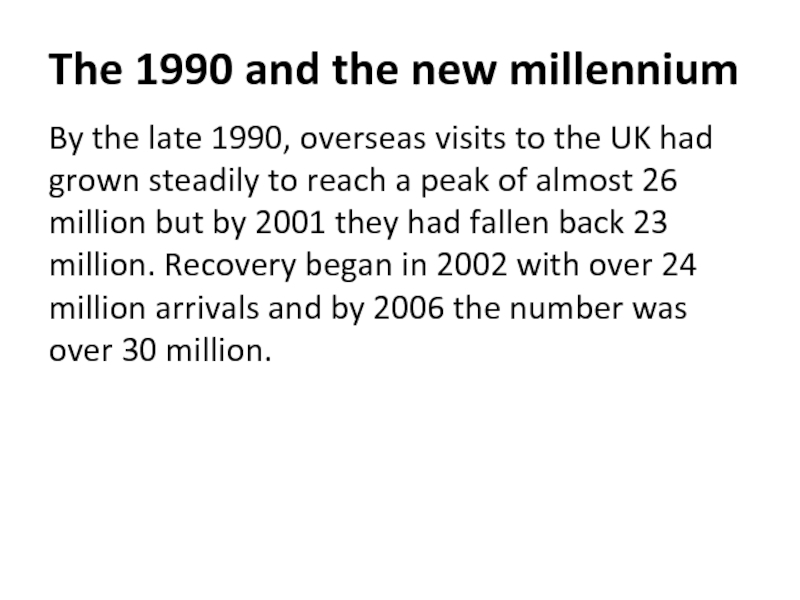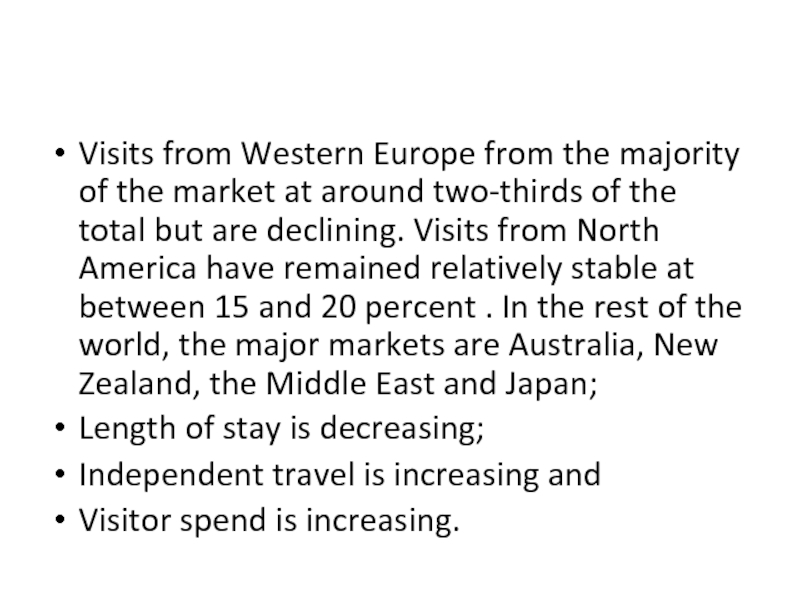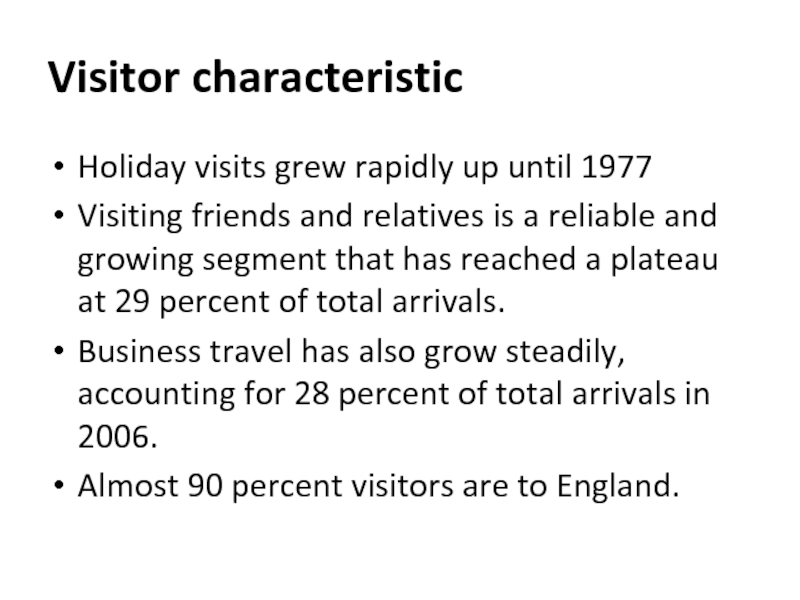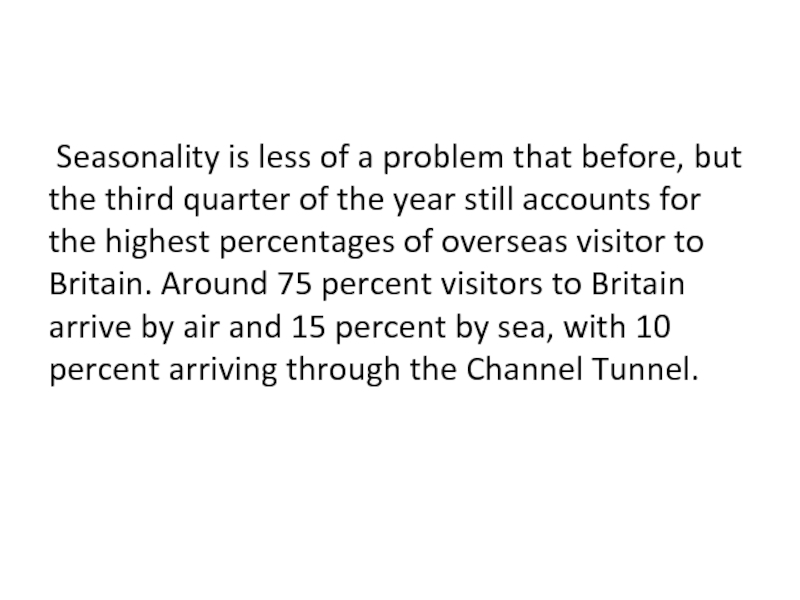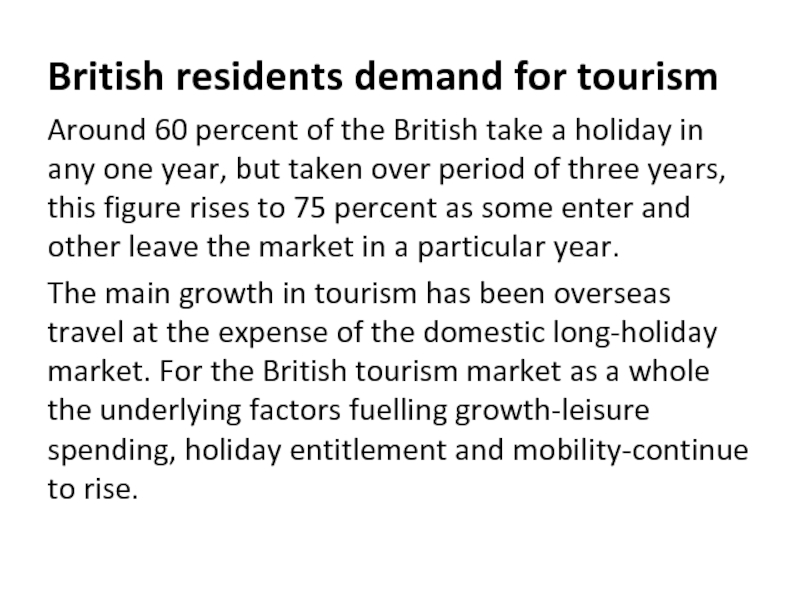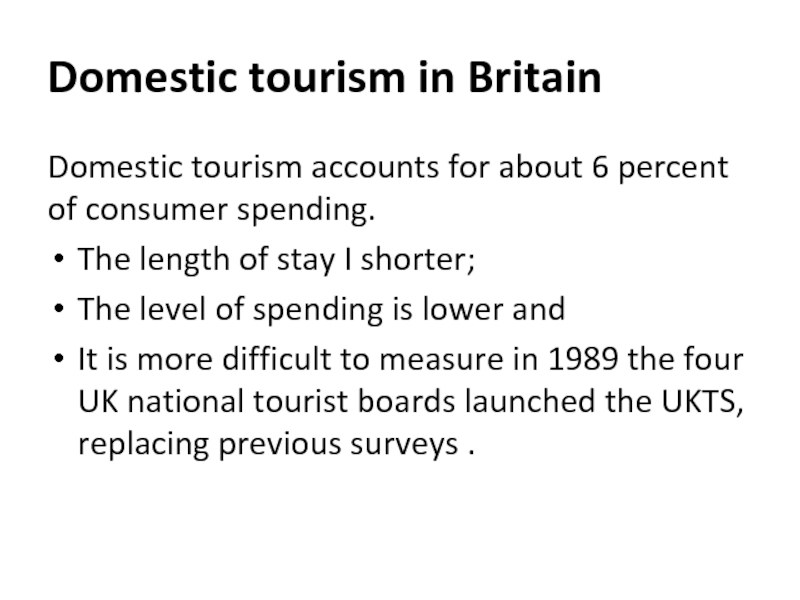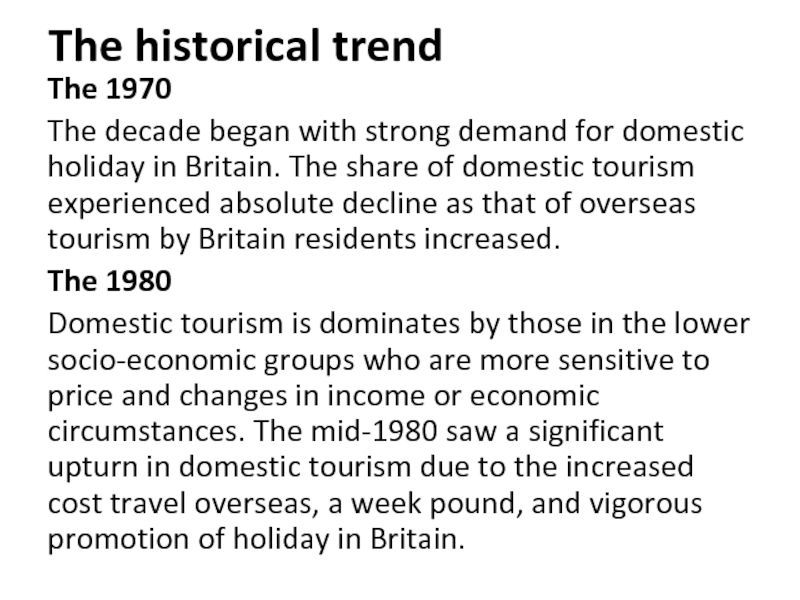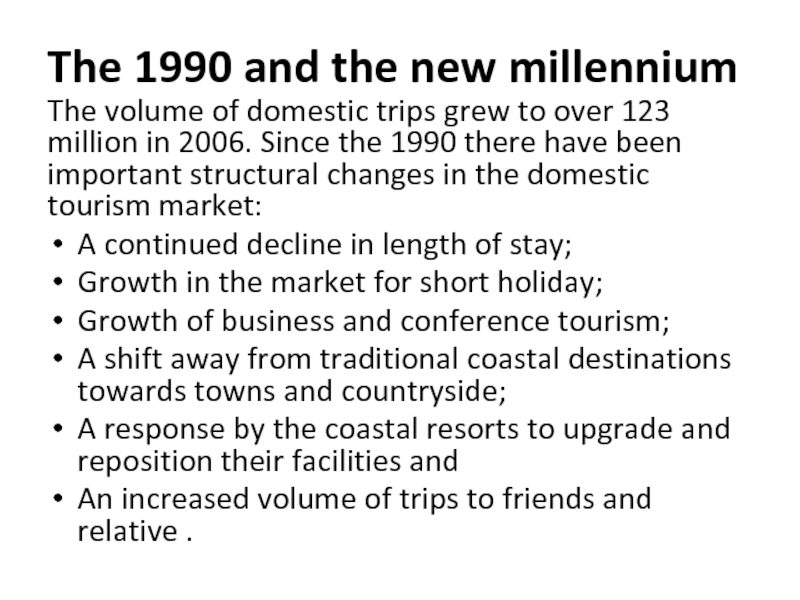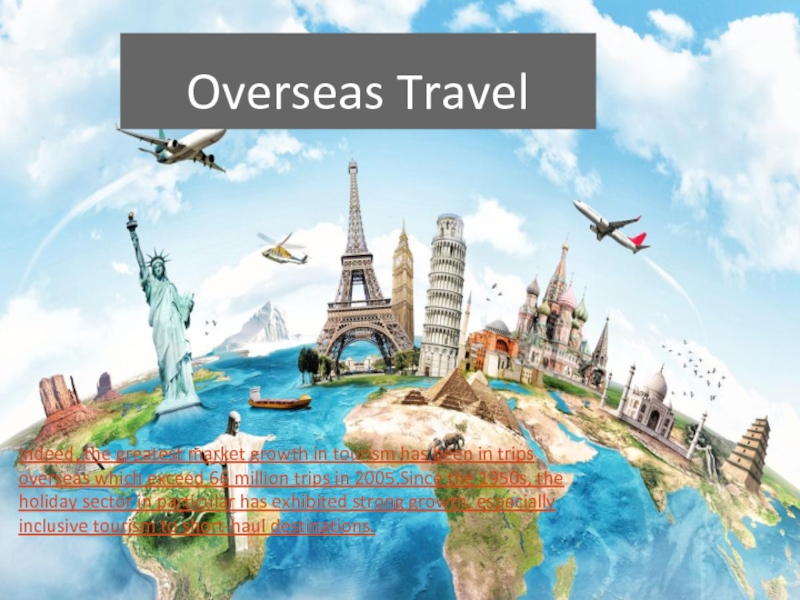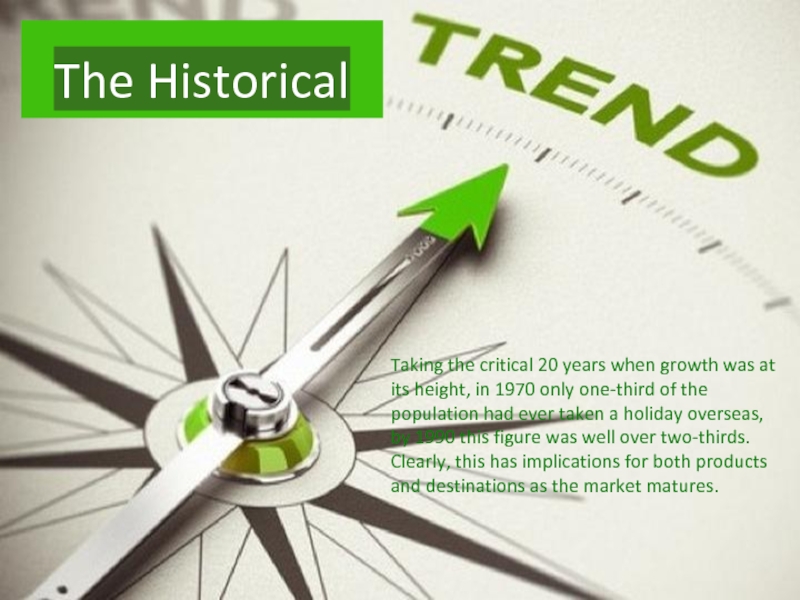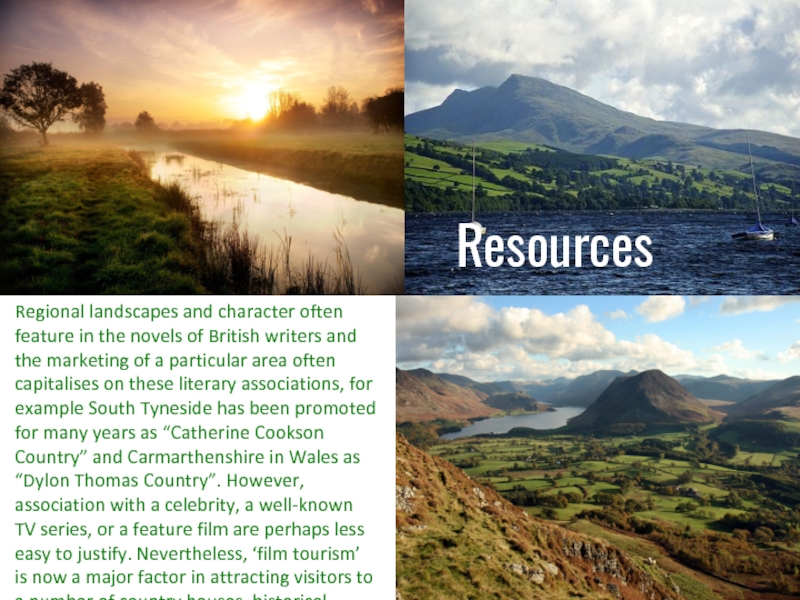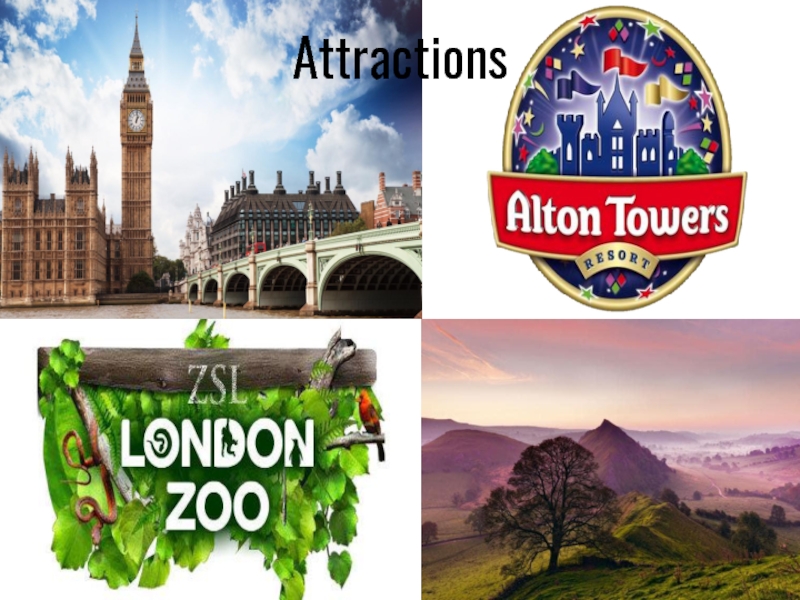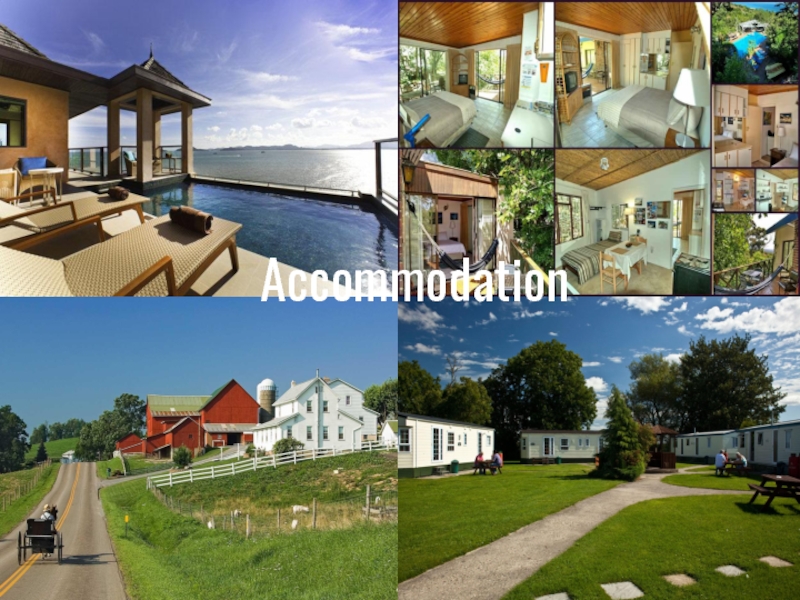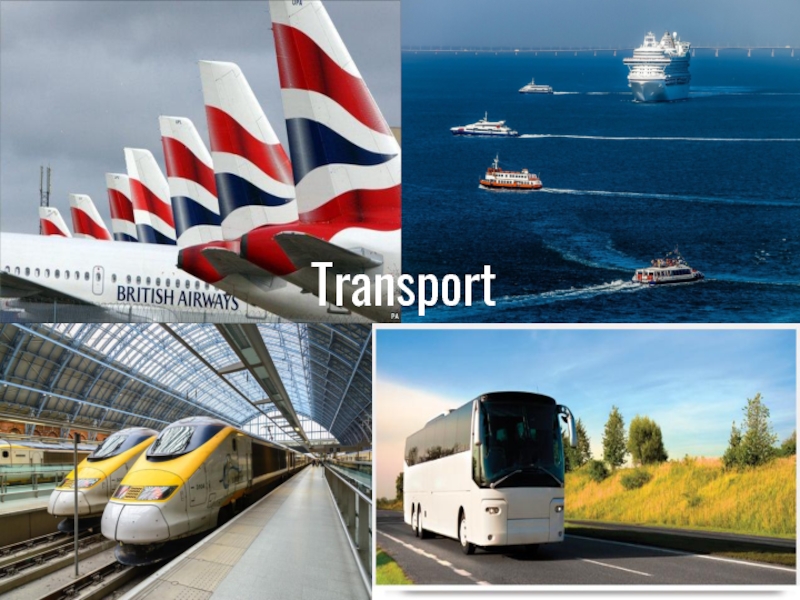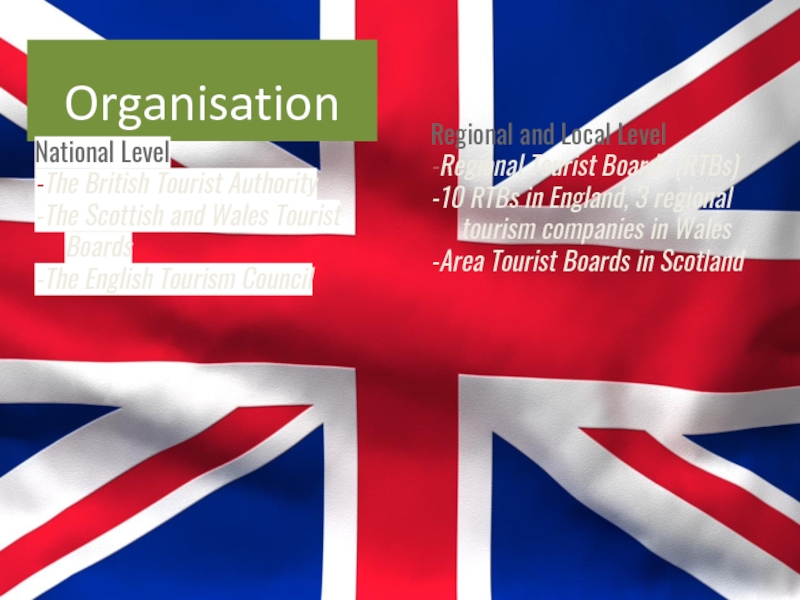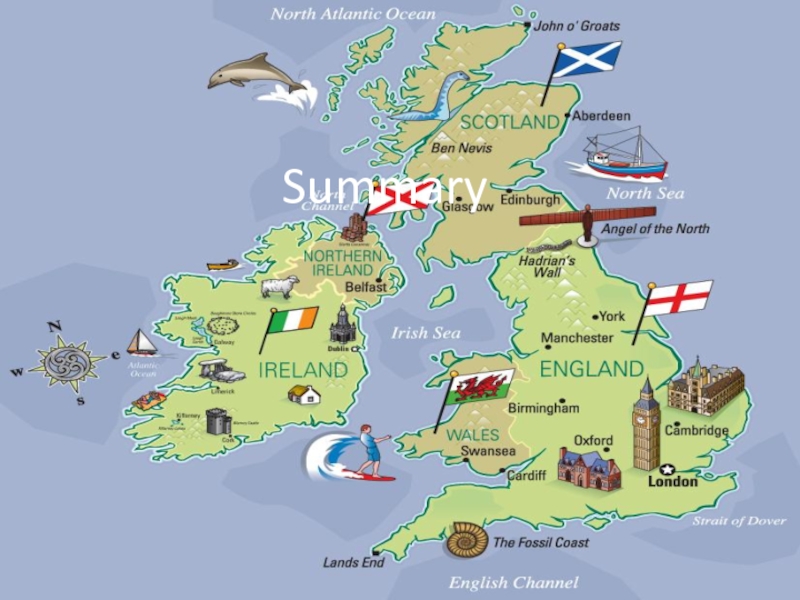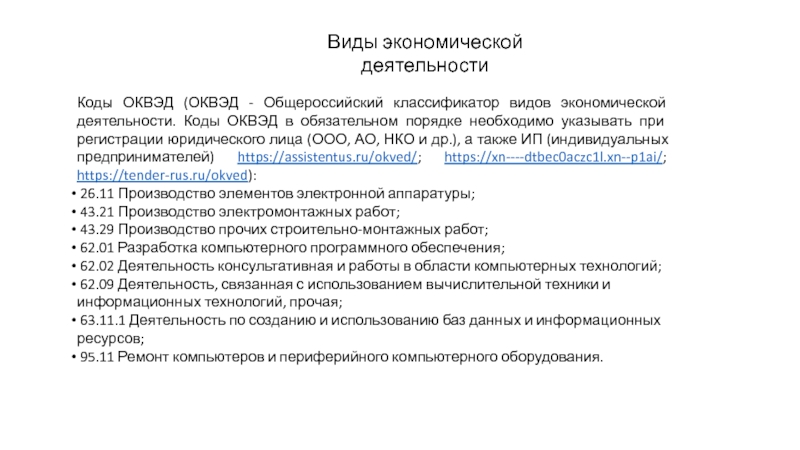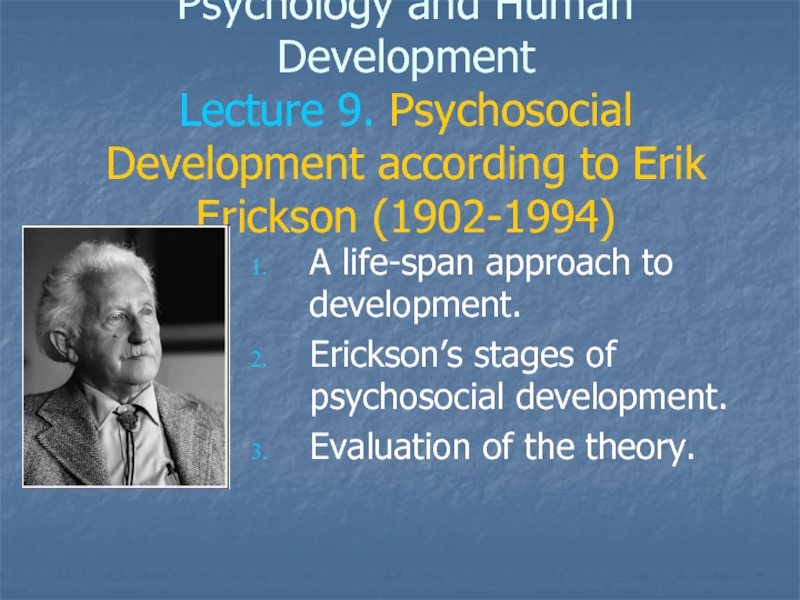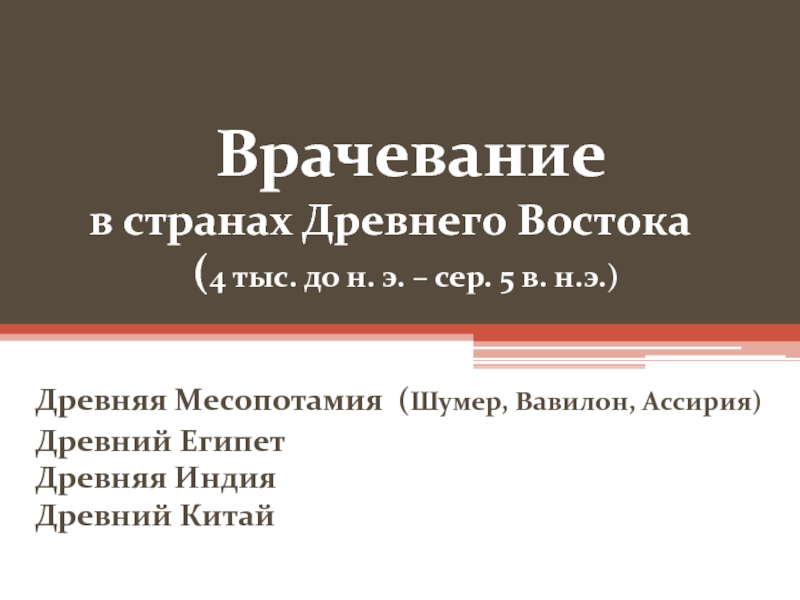Слайд 1An Introduction to the Tourism Geography of Britain
Слайд 2Introduction
Great Britain an Ireland are the two largest islands
in the group known as the British Isles, lying off
the north-west costs of Europe.
The naval heritage is an important part of Britain’s tourists appeal and
A cultural identity quite distinct from other west Europeans. The importance of tourism is clearly illustrated by these statistics for 2006.
Слайд 3Overseas arrivals to the UK exceeded 30 million;
The British took
69 million trip abroad;
The British took around 120 million domestic
tripe and
Tourism was estimated to support aver 2 million jobs directly and indirectly, and contribute almost 4.5 percent of GDP.
Слайд 4The physical setting for Tourism
Britain offers great variety.
Three landscape
zones as the physical setting for tourism:
The highland zone includes
Central and North Wales, the Southern Uplands and the Highlands and Islands of Scotland. Here rocks are older. The population is thinly scattered and land use is dominated by livestock rearing.
Слайд 5The upland zone includes Exmoor, Dartmoor, the Brecon Beacons, the
Black Mountains and the Pennines; and in Scotland, Caithness, Sutherland
and the Orkneys. Here rocks are younger. Britain’s national parks are mainly in the highland and upland zones where they have been designated for their natural beauty and characteristic landscapes.
Слайд 6The lowlands southern and eastern England. The lowlands are warmer
and drier, with intensive agriculture and sprawling conurbation dominating land
use.
The coasts are of major importance, particularly for domestic tourism. Most of the attractive stretches of coastline have been given protection as “Heritage Coasts” and there are plans to designate areas of the sea and sea bed as marine conservation areas.
Слайд 7Social and Economic influences
Social and economic changes in Britain
have combined to boost demand for both domestic and international
tourism. The 1960 were a particularly prosperous period of high employment in which the first real stirrings of mass demand for holidays abroad were experienced. Car ownership has increased rapidly over the period and, in 2005, car ownership stood at over 26 million vehicles.
Слайд 8The time available for holiday has also grown with increased
holiday entitlement, three-day weekends, and various flexible working arrangements providing
blocks of time for trip away from home. Since the 1990, legislation at the European level has increased workers entitlement to holiday and leisure time.
Слайд 9Between 1951 and 2001 the population in Britain grew by
less than 10 percent, despite large-scale immigration. The post-Second World
War baby boom produced a generation the demanded tourism and recreation from the late 1970 onwards.
Слайд 10Demand for tourism in Britain
Overseas visitors come to Britain
for heritage, culture, the countryside and ethnic reasons. The ebb
and flow of tourist movement in and out of Britain is due to the relative strength of sterling against other currencies, the health of the economy, special event attractions, the impact of international and national crises, and the marketing activities of both public and private tourist organizations.
Слайд 11The historical trend
The 1960
The early 1960 saw between 3
and 4million overseas visitors coming to Britain, but with the
devaluation of sterling in 1967 Britain became a very attractive destination.
The 1970
The number of overseas visitors has increased to 7 million visits by 1970. Spending by overseas visitors to Britain was greater than spending by British residents overseas. This was compounded by the Queen’s Silver Jubilee in 1977, which increased arrivals to 12 million.
Слайд 12The 1980
World economic recession also depressed visits in the
early 1980 but an upturn began in 1982, caused by
weaker pound and allied to economics recovery in the main generate checked by the Pan-Am bombing over Lockerbie, the Chernobyl disaster and the weakening of the US dollar.
Слайд 13The 1990 and the new millennium
By the late 1990, overseas
visits to the UK had grown steadily to reach a
peak of almost 26 million but by 2001 they had fallen back 23 million. Recovery began in 2002 with over 24 million arrivals and by 2006 the number was over 30 million.
Слайд 14Visits from Western Europe from the majority of the market
at around two-thirds of the total but are declining. Visits
from North America have remained relatively stable at between 15 and 20 percent . In the rest of the world, the major markets are Australia, New Zealand, the Middle East and Japan;
Length of stay is decreasing;
Independent travel is increasing and
Visitor spend is increasing.
Слайд 15Visitor characteristic
Holiday visits grew rapidly up until 1977
Visiting friends
and relatives is a reliable and growing segment that has
reached a plateau at 29 percent of total arrivals.
Business travel has also grow steadily, accounting for 28 percent of total arrivals in 2006.
Almost 90 percent visitors are to England.
Слайд 16 Seasonality is less of a problem that before, but
the third quarter of the year still accounts for the
highest percentages of overseas visitor to Britain. Around 75 percent visitors to Britain arrive by air and 15 percent by sea, with 10 percent arriving through the Channel Tunnel.
Слайд 17British residents demand for tourism
Around 60 percent of the
British take a holiday in any one year, but taken
over period of three years, this figure rises to 75 percent as some enter and other leave the market in a particular year.
The main growth in tourism has been overseas travel at the expense of the domestic long-holiday market. For the British tourism market as a whole the underlying factors fuelling growth-leisure spending, holiday entitlement and mobility-continue to rise.
Слайд 18Domestic tourism in Britain
Domestic tourism accounts for about 6
percent of consumer spending.
The length of stay I shorter;
The level
of spending is lower and
It is more difficult to measure in 1989 the four UK national tourist boards launched the UKTS, replacing previous surveys .
Слайд 19The historical trend
The 1970
The decade began with strong demand
for domestic holiday in Britain. The share of domestic tourism
experienced absolute decline as that of overseas tourism by Britain residents increased.
The 1980
Domestic tourism is dominates by those in the lower socio-economic groups who are more sensitive to price and changes in income or economic circumstances. The mid-1980 saw a significant upturn in domestic tourism due to the increased cost travel overseas, a week pound, and vigorous promotion of holiday in Britain.
Слайд 20The 1990 and the new millennium
The volume of domestic trips
grew to over 123 million in 2006. Since the 1990
there have been important structural changes in the domestic tourism market:
A continued decline in length of stay;
Growth in the market for short holiday;
Growth of business and conference tourism;
A shift away from traditional coastal destinations towards towns and countryside;
A response by the coastal resorts to upgrade and reposition their facilities and
An increased volume of trips to friends and relative .
Слайд 21Visitor Characteristics
The level of spending on overseas trips confirms
the high priority given to overseas travel by the British.
Examining the reason for the visit, holiday tourism is growing representing two-thirds of trips, business tourism accounts for 15 per cent and VFR for 12 per cent of trips.
Слайд 22Overseas Travel
Indeed, the greatest market growth in tourism has
been in trips overseas which exceed 66 million trips in
2005.Since the 1950s, the holiday sector in particular has exhibited strong growth, especially inclusive tourism to short-haul destinations.
Слайд 23The Historical
Taking the critical 20 years when growth was at
its height, in 1970 only one-third of the population had
ever taken a holiday overseas, by 1990 this figure was well over two-thirds. Clearly, this has implications for both products and destinations as the market matures.
Слайд 25Resources
Regional landscapes and character often feature in the novels of
British writers and the marketing of a particular area often
capitalises on these literary associations, for example South Tyneside has been promoted for many years as “Catherine Cookson Country” and Carmarthenshire in Wales as “Dylon Thomas Country”. However, association with a celebrity, a well-known TV series, or a feature film are perhaps less easy to justify. Nevertheless, ‘film tourism’ is now a major factor in attracting visitors to a number of country houses, historical towns and other locations throughout Britain.
Слайд 29Organisation
National Level
-The British Tourist Authority
-The Scottish and Wales Tourist Boards
-The English Tourism Council
Regional and Local Level
-Regional Tourist Boards (RTBs)
-10
RTBs in England, 3 regional tourism companies in Wales
-Area Tourist Boards in Scotland
